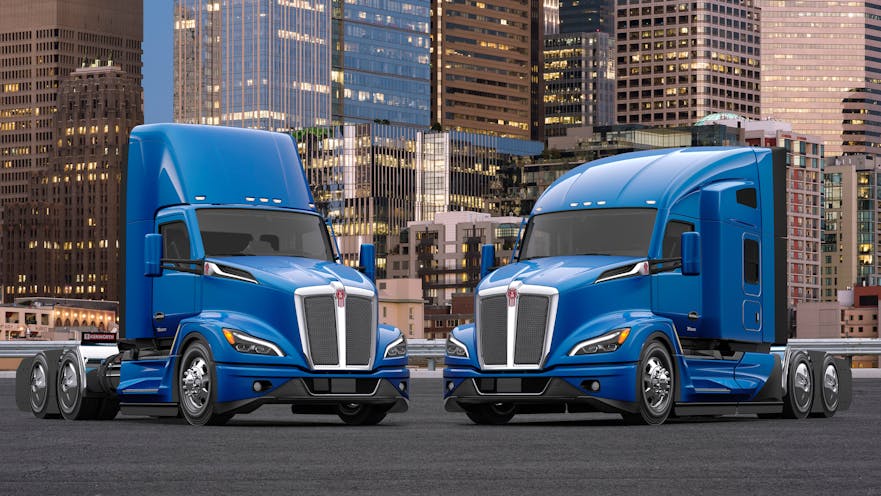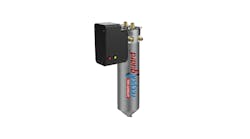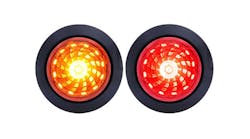To make the T680 Next Generation, Kenworth Trucking Co.’s on-highway flagship available for order in Q2 of 2021, the truck maker gathered up its engineers, aerodynamic experts, and styling team, gave them eight years of driver data since the original T680 was launched, and told them to have at it. Using race cars, iPhones, and well-crafted watches as muses, they came up with a refreshed tractor design as eye-catching as it is aerodynamic.
“The T680 Next Gen hit our design goal of being sleek and sophisticated," said Jonathan Duncan, design director, Kenworth. "We wanted to focus on the aerodynamics, the technology, and the refinement, and make the styling show that is a world-class, high-performance machine.”
And it’s really aerodynamic. So aerodynamic, in fact, that the T680 Next Gen 76" sleeper with the EPA 2021 MX-13 engine increases fuel efficiency by 6 percent over the comparable classic with the 2017 MX-13.
“We think the T680 Next Gen will become the new standard when it comes to fuel economy,” said Joe Adams, Kenworth’s chief engineer, during the February 11 virtual launch. “Coupled with the sleek look of the truck, it’s going to raise eyebrows.”
Noticeable contour enhancements include a new aero bumper and hood, turning vanes, durable lower fairing extensions, chassis fairings, wheel well closeouts, 28" side extenders, tandem drive axle fairings, and wheel covers. These work in concert to guide airflow closer to the cab to reduce drag-causing turbulence. While the truck glides down the road, the redesigned air dam guides airflow under the chassis to reduce friction and move hot air away from the radiator and engine for better cooling.
For drivers accustomed to the classic T680’s aero bumper’s approach angle and ground clearance, the good news is Kenworth kept those the same. The most profound change on the sleeper models is a pair of fairing extender “doors” jutting from the back to close the gap between truck and trailer. They swing open and closed so “the drivers have clear access to the back of sleeper to do any of the things they need to do in their daily inspection,” Adams explained.
To reduce the trailer gap by 38" to 42", an alternate chassis package with a shorter wheelbase can be spec’d.
The litany of improvements starts with those curves along the truck’s body, but it’s got plenty of bling as well, in the form of bold heated LED headlamps and additional turn signal indicators adorning the fenders’ backside near the driver and passenger steps.
“It gives us as designers a nice cool blade of light down the back of the fender and really gives it an expressive look, but for the driver, it makes sure that everybody coming up alongside of you, especially folks in passenger cars, they can see what you're going to do - you turn that turn signal on, they can't they can't miss it,” Duncan asserted.
Adams added on a media call after the presentation that the side signals also provide the driver with “peace of mind” and more confidence down the road.
While the exterior was designed to turn heads on the road, the driver’s gaze will often drift to the 15" high-definition Digital Display on the dashboard.
“We were seeing the drivers weren't necessarily using the level of depth that is in typical instrumentation, so the freedom of a completely glass cockpit just opens up the door to letting us do what the driver needs and showing it to them when they need it,” said Steve Jahns, user experience and ergonomics design lead.
The display provides all the requisite gauges like the odometer and fluid levels, and specific data, such as tire pressure and driver performance metrics, can be displayed and moved around according to the driver’s preference, which can be saved as a profile. Kenworth said the future road map includes adding more than one savable profile for trucks with multiple drivers.
The screen also displays a collision mitigation system to provide distance to the vehicle ahead and provides visual cues if the truck is following too close. The screen will turn red if the advanced driver assistance system calculates a crash is imminent.
Controls including instrumentation, adaptive cruise control, and phone and radio can all be controlled with a push of a button on the Next Gen SmartWheel. With the addition of Torque Assisted Steering, more force is directed to the steering column to reduce driver fatigue and stress, Adams explained.
How much torque is applied depends on speed: more at low speeds and less at higher speeds. The system also adjusts to heavy crosswinds that might work against the truck.
Optional lane-keeping assist, available when spec’ing the Bendix Fusion Wingman safety system, uses cameras to detect if the truck is veering out of its lane and provides a “nudge” to get back in it. This feature comes with Torque Assisted Steering.
The T680 Next Gen's duty cycles include line haul, pickup and delivery, and regional haul. Configurations include daycab, 40", 52", and 76" sleeper. Kenworth said the 76" high-roof sleepers come with the option of a 5.5" storage shelf with multiple secure tie-down points and two LED lights on the shelf’s underside provide lower bunk lighting.
To class up the cab even further, customers can spec the Diamond VIT interior that adds rich madrona (a reddish-brown hue like mahogany) inserts with diamond-pattern black stitching to the door pads.
For a closer look at the T680 Next Gen, cycle through the slideshow.




